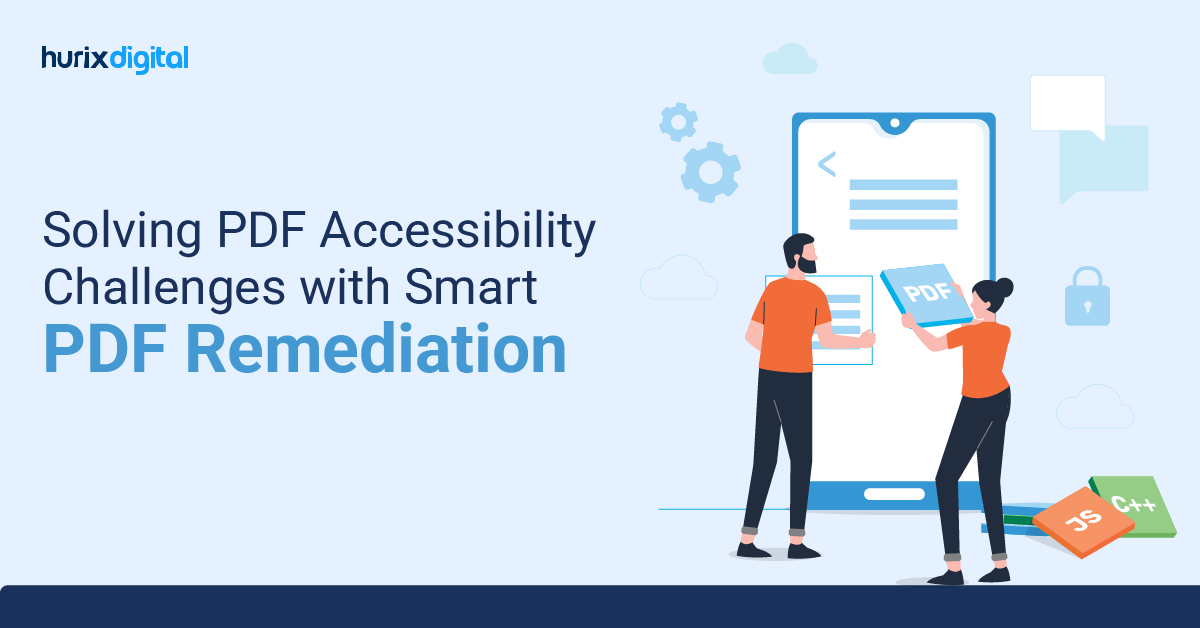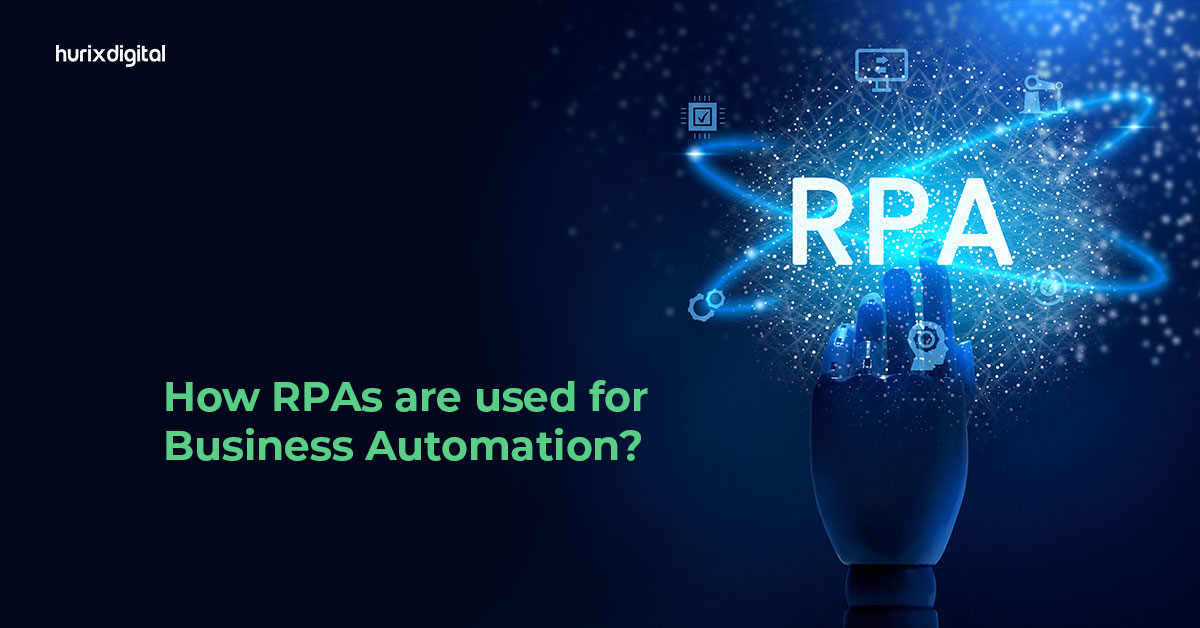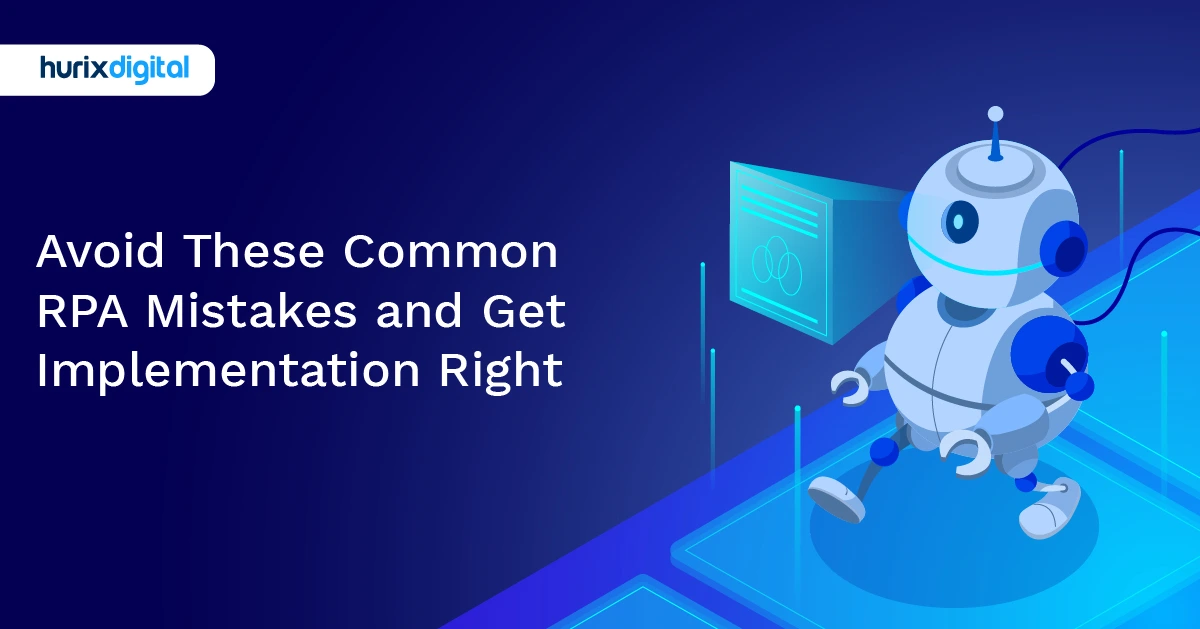
Avoid These Common RPA Mistakes and Get Implementation Right
Summarize with:
Automation has become a game-changer in business, streamlining business operations and creating new growth opportunities. Today, nearly two-thirds of organizations use automation in one or more of their business processes.
Among the various automation technologies available, Robotic Process Automation (RPA) has emerged as a powerful tool for digital transformation. RPA technology is effective for automating manual tasks and improving efficiency.
However, it has limitations when handling unstructured data, making intelligent decisions, or adapting to dynamic situations. This is where AI complements RPA. Together, they can provide more accurate and efficient automation powered by an informed knowledge base.
According to a recent Deloitte research, 73% of global executives admitted to having embarked on a path of intelligent automation. Read on to find out how RPA and machine learning can work together to offer intelligent automation.
To help you employ robotic process automation tools, we’ve outlined the essential steps to take when embarking on an RPA project. These best practices will help you confidently navigate RPA implementation.
Table of Contents:
- What is Robotic Process Automation?
- What Tasks Can RPA Perform?
- Challenges with RPA Implementation
- What are the Critical Steps for Successful RPA Implementation?
- RPA and Machine Learning = Cognitive Automation
- What are the Business Benefits of Cognitive Automation?
- Conclusion
What is Robotic Process Automation?
Robotic process automation (RPA) is an automation technology that employs machine learning and artificial intelligence tools to automate repetitive tasks. RPA operates 24×7, delivering efficient results without the need for human intervention.
For instance, businesses often struggle with completing mundane tasks like data entry, document generation, and editing. RPA can finish tasks like these quickly and efficiently, allowing you to save time, money, and resources.
What Tasks Can RPA Perform?
Robotic process automation can perform a huge variety of tasks across numerous industries. Through its optimal functionality, RPA can unlock efficiencies that add great value to your business and drive rapid innovation.
Here are some popular RPA use cases:
- Data entry & migration
- Data validation
- Data collection & analysis
- Report generation and editing
- Invoice processing
- Financial auditing
- Customer service support
- Employee support and management
- IT support and maintenance
- Supply chain management
Challenges with RPA Implementation
RPA indeed offers several benefits to organizations across dimensions. As per Deloitte’s Global Robotics Survey, it has improved productivity for 95% of its users, compliance for 93%, and reduced costs for 81%.
However, implementing RPA for business process automation is not without its challenges. Identifying these challenges will prepare organizations and enable them to create strategies to overcome them.
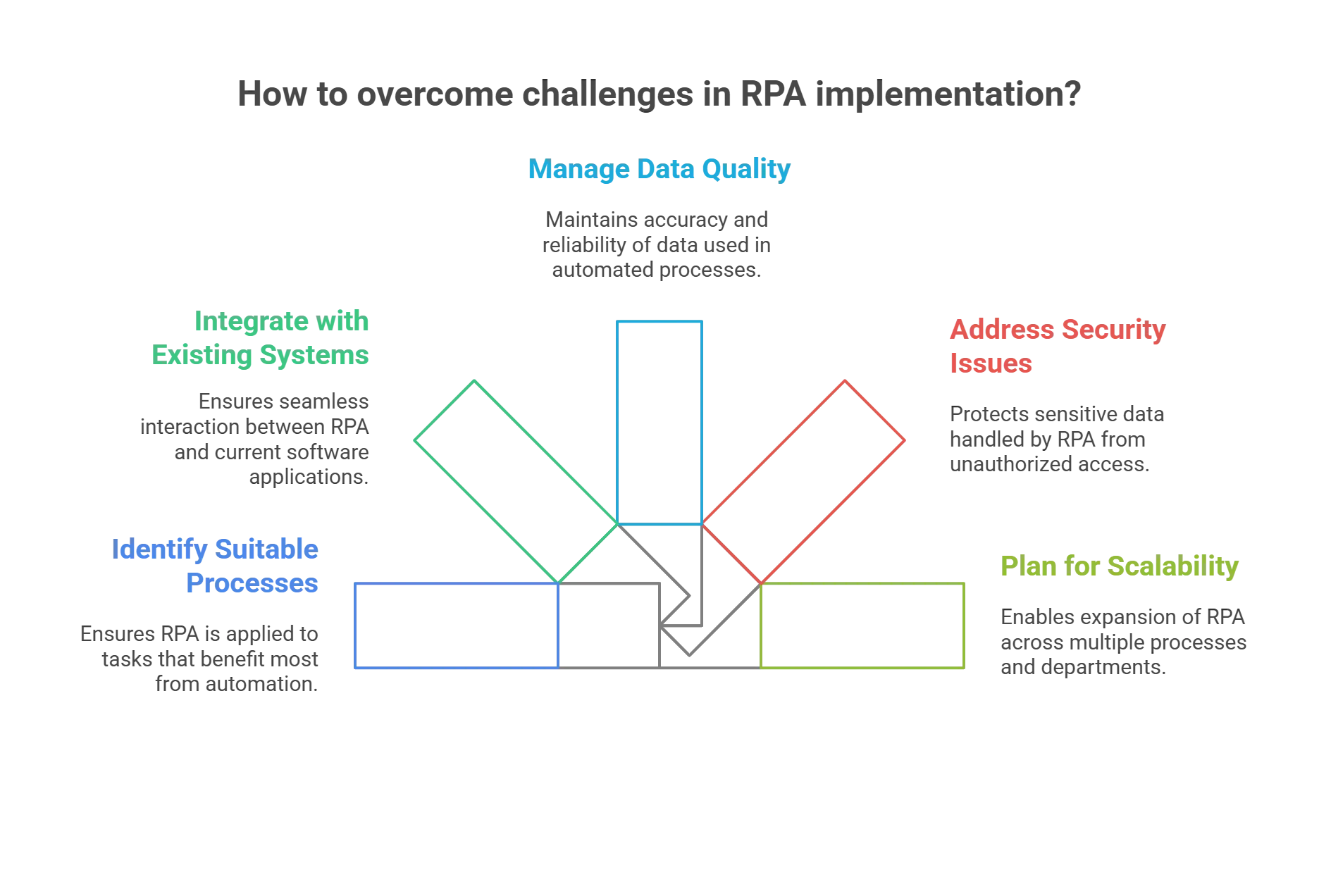
Here are the common challenges associated with RPA deployment:
1. Identifying Process Suited for RPA
Not all tasks are suitable for RPA. Ideally, the RPA process is well suited for rule-based and repetitive tasks that require working with large data volumes. Identifying which processes to automate and which not to can be tricky.
2. Integrating RPA with Existing System
RPA programs do not work in isolation but must interact with various software applications. Sometimes, these systems may not be compatible with the automation software. You may have to put in extra effort to make everything run smoothly.
3. Data Management Challenges
Automation tools rely heavily on accurate and reliable data to perform tasks. If the data is incomplete or inconsistent, it can lead to errors in the automated processes. Hence, maintaining data quality and integrity becomes crucial for successful RPA implementation.
4. Security Issues
RPA involves robots handling sensitive data and performing tasks on behalf of humans. Ensuring the security of the data they handle is of utmost importance. Adequate security measures must be implemented to prevent unauthorized access and data breaches.
5. Scalability Concerns
Despite leaders supporting RPA implementation, organizations struggle to scale RPA as anticipated. The main barriers include fragmented processes (32%), lack of clear vision (17%), and lack of IT readiness (17%). Organizations must carefully plan RPA scaling across multiple processes and departments.
What are the Critical Steps for Successful RPA Implementation?
Implementing Robotic Process Automation requires careful planning. Common automation mistakes can hamper its successful execution. To avoid failure, do not miss out on these critical RPA implementation steps:
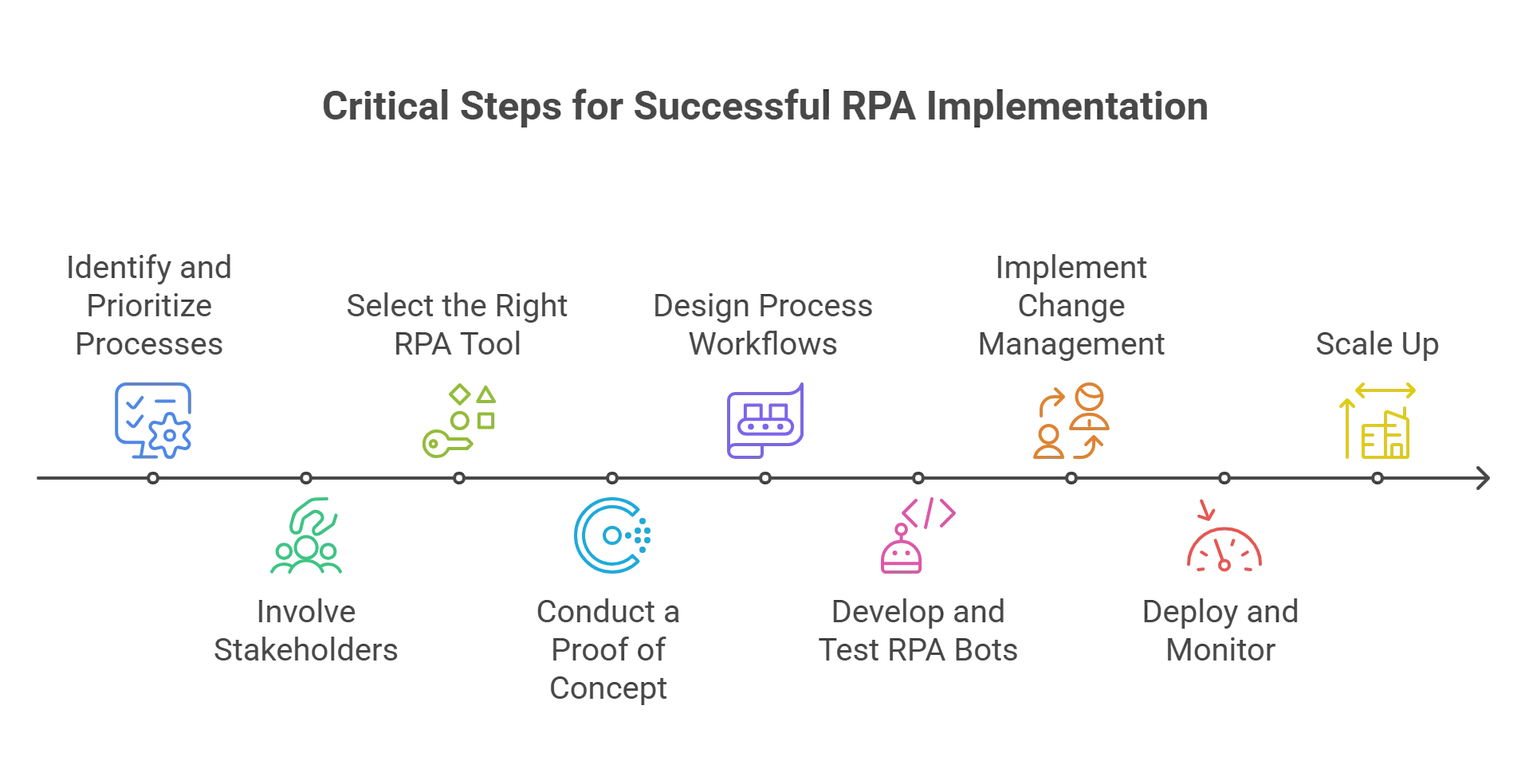
1. Identify and Prioritize Processes
Start by identifying which tasks are best suited for automation. As mentioned above, look for repetitive, consistent, and rule-based processes. Some examples of such tasks are data entry, invoice processing, reconciliation, report generation, client onboarding, KYC, etc.
These tasks are less complex to automate and will ensure a smoother implementation. Also, prioritize RPA implementation on processes that will significantly improve efficiency and cost-saving from automation.
2. Involve Stakeholders
When implementing any new technology, it’s crucial to involve key people from the organization affected by it. For RPA, it could be process owners, IT teams, and employees.
Listen to their input and insights, and address their concerns. The adoption of RPA will become more effective with their support and cooperation.
3. Select the Right RPA Tool
When it comes to robotic process automation tools, there is no one-size-fits-all. Each business has to conduct its research and choose an RPA tool that meets its needs. The most important factors you should consider when selecting automation platforms are:
- Functionality and Features
- Ease of Use
- Compatibility with Existing Systems
- Customization and Scalability
- Security and Data Protection
- Vendor support and reputation
- Cost and Pricing Model
Evaluate different options with the help of your IT teams. Most vendors offer free trial options, so take advantage of them.
4. Conduct a Proof of Concept (POC)
It’s always prudent to conduct a feasibility assessment of the RPA program first through a small-scale proof of concept. Select a representative process and run the automation to evaluate its effectiveness.
Did the process benefit your team? Gather their feedback, address their challenges, and make adjustments. Your team must have confidence in the chosen RPA tool before you decide to scale the process across the organization.
5. Design Process Workflows
While developing RPA, you must include all necessary steps in the process. Map out the step-by-step workflows for the processes to be automated. Document the inputs, outputs, decision points, and actions the RPA tools will perform.
This detailed design will act as a blueprint for the development team and provide them with clarity during implementation.
6. Develop and Test RPA Bots
Once you have designed the RPA process workflows, it’s time to bring them to life by developing the RPA bots. These bots will interact with the required software applications and manage data.
But before they go live, thorough testing is crucial. Test the bots in various scenarios to ensure they can also handle exceptions if they arise.
7. Implement Change Management
It’s normal for staff to resist IT process automation. The key to overcoming the resistance is communication. Communicate the purpose and benefits of RPA to your employees and address any concerns they may have.
Provide training to help them adapt to the new automated processes. Emphasize how RPA enhances their work instead of replacing it. Clear communication and ongoing support will make the transition smoother for everyone.
8. Deploy and Monitor
Once your RPA bots have passed the testing phase, it’s time to deploy them into the production environment. But your job doesn’t end with deployment. It’s crucial to monitor their performance.
Review key metrics to ensure RPA programs operate efficiently and deliver the expected results. Proactive monitoring allows you to identify issues and address them promptly.
9. Scale Up
After successfully automating the initial processes, it’s time to think bigger. Identify additional tasks or processes that can benefit from RPA and expand the automation across different departments or functions.
First, create a roadmap for scaling up your RPA implementation. Evaluate new opportunities and gradually expand automation to unlock the full potential of RPA across your organization.
RPA and Machine Learning = Cognitive Automation
Cognitive automation combines AI technology with business automation systems to provide computers with the capacity to do tasks requiring cognitive abilities similar to those of humans.
When humans perform tasks, they use their perception, memory, intuition, reasoning, and judgment. They also keep the context in mind when processing information. Cognitive automation allows machines to do similar things.
With cognitive automation, machines can analyze massive amounts of data, identify patterns, understand and respond to human language, and reach sound conclusions. In simpler terms, they enhance automation’s intelligence and human attributes.
No wonder that 45% of organizations scaling automation combine RPA with AI.
What are the Business Benefits of Cognitive Automation?
Introducing artificial intelligence in business opens a tremendous potential for growth. Here are some apparent benefits of AI in company automation:
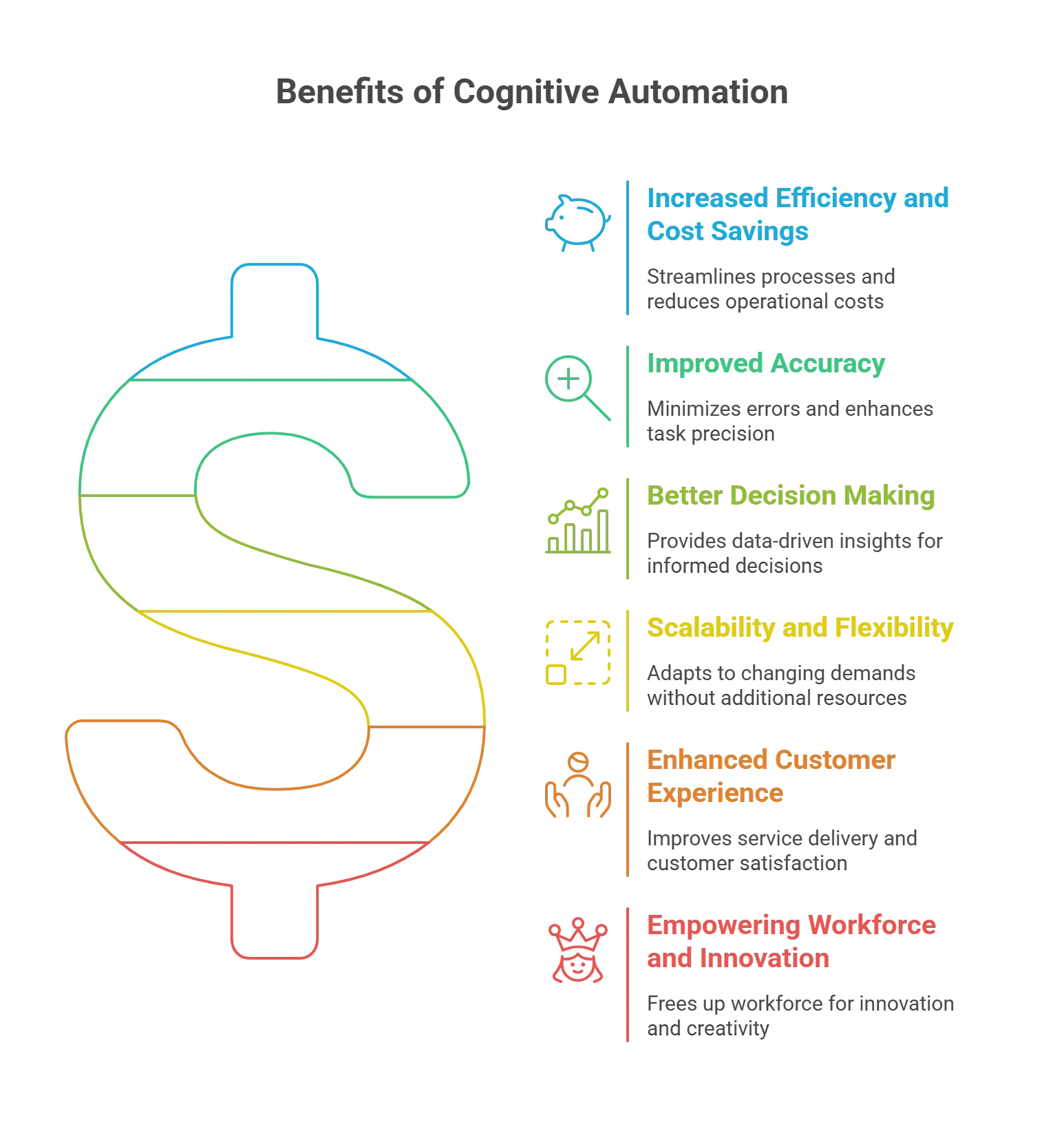
1. Increased Efficiency and Cost Savings
Unlike standard RPA, cognitive automation can handle complex data and processes efficiently. Automating these complex process save businesses the time and cost of hiring additional resources to complete the same.
Organizations implementing intelligent automation have already received an average 27% cost reduction from implementation to date.
2. Improved Accuracy
Cognitive automation tools not just complete tasks but also improve their accuracy. They minimize the chances of human errors by following logic consistently with the help of advanced technology like AI and machine learning.
Accurate task completion contributes to quality services and higher customer satisfaction.
3. Better Decision Making
By leveraging AI, automation tools can extract valuable insight from data and help you make data-driven decisions. They can analyze large volumes of data and identify patterns and trends.
With it, you will have information at your fingertips when making important business decisions.
4. Scalability and Flexibility
Cognitive automation tools can easily adapt to higher demands without additional equipment or human resources. It enables businesses to scale seamlessly without incurring significant costs.
These flexible systems are also capable of performing optimally during unexpected situations.
5. Enhanced Customer Experience
Cognitive automation has a significant impact on how customers view your company.
Automating consumer engagement allows you to deliver services more quickly and personalize responses. This boosts consumer satisfaction and brand loyalty.
6. Empowering Workforce and Innovation
Cognitive automation management handles mundane and repetitive tasks, enabling your team to utilize their time and expertise better. This not only boosts their morale but also encourages innovation.
Conclusion
At Hurix Digital, we specialize in automating business processes to improve efficiency and accuracy. Our dedicated team of professionals focuses on research, innovation, and strategic recommendations to maximize your ROI.
We provide cost-effective and scalable RPA solutions that drive enterprise-wide transformation. We go beyond conventional automation by integrating machine learning and artificial intelligence, enabling a true digital transformation for your business.
From strategy to implementation and continuous improvement, we provide comprehensive RPA services that ensure error-free output and drive business value.
Contact us today to harness the power of RPA and unlock the full potential of your business.
Frequently Asked Questions (FAQs)
Q1: What causes RPA projects to fail?
A1: Choosing complex processes, skipping stakeholder buy‑in, and neglecting change management often derail RPA deployments.
Q2: How important is process documentation for RPA?
A2: Very—detailed process maps and exception handling are essential for reliable automation outcomes.
Q3: When should RPA be scaled?
A3: After successful pilots show ROI, automated SLAs, and stable bot reliability for broader deployment.
Q4: How can bot mistakes be minimized?
A4: Include thorough testing, exception handling, audit trails, and clear recovery steps in bot design.
Q5: Do bots need ongoing maintenance?
A5: Yes—process updates, system changes, and compliance audits require regular bot monitoring and tuning.
Summarize with:

Vice President & SBU Head –
Delivery at Hurix Technology, based in Mumbai. With extensive experience leading delivery and technology teams, he excels at scaling operations, optimizing workflows, and ensuring top-tier service quality. Ravi drives cross-functional collaboration to deliver robust digital learning solutions and client satisfaction
 Upcoming Masterclass | Build an Army of Brand Evangelists using Training & Development | November 20th, 8:30 AM PDT | 11:30 AM EDT | 10:00 PM IST
Upcoming Masterclass | Build an Army of Brand Evangelists using Training & Development | November 20th, 8:30 AM PDT | 11:30 AM EDT | 10:00 PM IST



